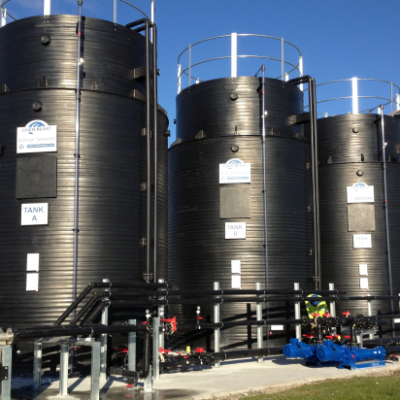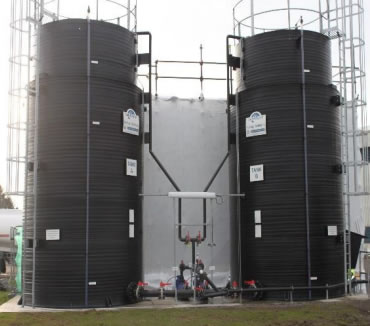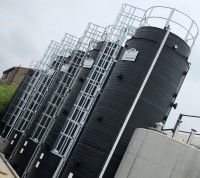BUNDED CHEMICAL STORAGE USE CASES
Today, many clients face the challenge of needing to maximise their chemical storage capacity within the same limited site space. We can help resolve this in environments with no height restrictions by “building tall” and manufacturing taller replacement chemical tanks with close proximity bunds to sit within a minimised footprint. A recent example of this would be illustrated in our work with Christeyns who grew their capacity by 60%.
A direct benefit of reducing the chemical tank diameters is the reduction in Civils costs by using less concrete; which also has a positive impact on an organisation’s carbon footprint.
We have the capacity to manufacture Bunded Chemical Storage Tanks in the region of 100,000l capacity. Every bunded chemical storage tank we design meets our customers exact requirements and conforms to the British and European standard BS EN 12573: 2000 ‘Welded static non-pressurised thermoplastic tanks’. We specialise in using thermoplastics due to their inert nature when dealing with some of the most aggressive chemicals. Specifically, we use Corrosion Resistant Polypropylene and High-Density Polyethylene (PE100-RC).
BUNDED CHEMICAL STORAGE TANKS ADVANTAGES:
- A broad range of chemical resistance
- Corrosion resistance both internally and externally
- The ability to specify a chemical tank design life with unlimited fill and empty cycles
- Lightweight chemical tank construction leading to reduced installation costs
- Resistance to stress cracking (PE100-RC)
BUNDED CHEMICAL STORAGE TANKS ADDITIONAL FEATURES:
- Flat, Sloping and Coned base construction
- Heating, insulation and cladding
- Integrated safety bunds, an alternative to lined concrete bunds
- Rain-skirt for external siting
- Improved access options: including ladderwork, handrails and roof strengthening
- Recirculation systems
chemical storage bunding options
- We can manufacture chemical storage tanks ranging from 800mm to 4300mm in diameter
- Our chemical holding tanks have high capacities with volumes up to 130,000 litres
- The manufacturing process we use produces chemical storage tank solutions with wall thicknesses up to 140mm.
- Beige Polypropylene (RAL 7032)
- Black, High-Density Polyethylene (RAL 9055)
- Any RAL colour can be chosen to enable the provision of chemical storage tanks to suit the surroundings or planning requirements (additional costs may apply)
Some of the many chemicals stored in Chem Resist chemical storage tanks are:
- Sulphuric acid
- Hydrochloric acid
- Hydrofluoric acid
- Nitric acid
- Sodium hypochlorite
- Sodium hydroxide
- Ammonia solution
- Ferric sulphate and chloride
- Aluminium sulphate
- Polymers
- Salt solutions
- Interconnecting Ductwork
- Gas Scrubber: for Fuming Chemicals
- ChemiGuard Tanker Offload Cabinet: Increasing Safety During Offload (Available as Pressurised and Pumped)
- Chemical Fill Pipework
- ChemiGuard Pump Enclosure: Providing Safe Chemical Transfer
- Secondary Containment Bund
- Level Instrumentation (Radar, Level Switches, Cat & Mouse)
- Roof Access Ladders and Perimeter Handrails
WHAT IS A BUNDED CHEMICAL STORAGE TANK?
Bunded chemical storage tanks have been specifically designed for the storage of corrosive and aggressive chemicals. A bund for chemical storage is ‘a ‘facility (including walls and base) built around an area where potentially polluting materials are handled, processed or stored, for the purposes of containing any unintended escape of material from that area until such time as remedial action can be taken’. As defined by Ciria, chemical storage bunds must be ‘structurally independent’ from the primary containment tank. A bunded storage tank is essentially a tank within a tank, as both the storage tank and bund are fabricated independently, both comprising of their own cylinder and base. Bunded chemical storage tanks provide an alternative to concrete lined bunds. A welded rainskirt prevents the ingress of water if the location is external.
Tanks being ‘double skinned’ or ‘double walled’ differ from bunded tanks as these constructions involve both ‘skins’ or ‘walls’ being welded to a single base and do not provide true secondary containment.
Enquire About This Product
If you have a technical specification available, please complete our technical quotation form and we will be able to provide you with an accurate quote.
Click here to send your full specification
Alternatively, contact us on +44 1924 499466 or [email protected].
Download the white paper:
“THE CHEMICAL STORAGE CARBON FOOTPRINT”
If you’re interested in learning more about Chemical Storage tanks manufactured using the Spiral Wound method – how they can be used to benefit your organisation and the environment when compared to the alternatives – download our white paper to learn more about the carbon footprint of chemical storage.
Prepared by Chem Resist Sales Director Gary Smith and Technical Manager Stephen Menzer, the white paper breaks down both the business and environmental case for spiral wound manufacturing.







